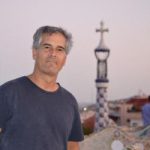Guitars Without Borders: A Night at a House Concert
I’m reclining on a couch with large, cushy black pillows. Just relaxing. And listening. Live acoustic guitar music provides a perfect soundtrack for the magical view I have beyond the wide picture windows. In the distance, the shimmering blue Pacific Ocean spreads across to Monterey. Does it get any better than a midsummer evening house concert in California?
A small gathering of 50 lucky souls have gathered at my friend Eric’s house to soak in the sounds of three of the world’s finest guitarists, each bringing a different flare to their strings. And it’s the first time the three have performed together. Alex DeGrassi has been performing and recording for more than 30 years and is well known for his Windham Hill albums. He’s joined by Italian fingerpicking virtuoso Franco Marone and West-African influenced guitarist Walter Strauss. During the course of the evening I had a chance to speak with each of the guitarists about their craft.
Sitting on the porch before the show, Franco told me about his early love of acoustic music from the ‘60s, particularly Joni Mitchell, Bob Dylan and Crosby, Stills, Nash & Young. He later discovered Leo Kottke and Ry Cooder.
“At the beginning my interest was not for guitar,” explains Franco. “I was more interested in listening to music. Step by step I discovered playing.” He performed with various rock bands while attending college in Bologna, Italy and performed at various osteria (pubs). “It was really strong folk and blues music,” he remembers.
Sitting in front of a stone fireplace, Franco begins playing “Tarantella” and follows up with a funky blues piece. The sound pulses across the two rooms, where a large Buddhist painting hangs on the wall and candle light is reflected in a mirror. The music is meditative and uplifting, complex and sweet. The three guitarists play solo, in pairs, and finally come together as a tight trio for a number of songs, including a dynamic rendition of “Paint It Black” set in 7/8 time with a Middle Eastern feel.
“There are different ways to play music,” says Franco. “For me it is more a spiritual experience. I don’t have the goal to surprise the listener with ability and virtuoso. Many of my colleagues like to have the audience say, 'That’s incredible!' But I’m not interested in showing ability like in a circus.” (Of course, the irony that night was that during intermission, audience members use the word “incredible” to describe this humble Italian musician.)
Alex DeGrassi is warm and friendly as he speaks about his lengthy career as a guitarist: “I feel at my best when I feel connected. One thing I was able to do pretty early on with my solo guitar music is write music that conveys some kind of mood or sense of place, or sense of motion and movement.” As an example he mentions his 1998 album, Water Garden.
“Connection to the process is what’s important,” he explains. “The audience may get something completely different from it, but what they always feel is that the music is connected to something. And it helps them connect with something in their life. It takes people and transports them somewhere. Most good music does that, no matter what kind of music it is.” During his set Alex treats us to original songs and covers of tunes by Charles Mingus and Jimmy Hendrix, which he plays on a sympatar—a sitar-like guitar.
Walter Strauss is hooked on African music. Specifically, the captivating polyrhythms of West African kora (harp) and kamal’ngoni (hunter’s harp). Walter has performed and recorded with master African musicians Toumani Diabate and Mamadou Sidibe, both from Mali. He’s translated this traditional music to guitar and the results are stunning. Near the end of the concert, after sunshine has faded to night, Strauss plays an original song about Ishi, the last indigenous person of California who was discovered in 1911 and lived out his life at the Museum of Anthropology in San Francisco.
“In the larger sense [Ishi] was an exhibit. But I think the interesting thing is how open he was,” Walter tells me after the show. “In the song I say, ‘Arrowheads and blessings passed on to anyone who met his eye.’ Even though he was in this absurd position of being almost this captive behind glass, he was gracious and taught people how to create arrowheads and showed them the ways of his people. He’d go to the hospital and sing the healing songs of his people to the dying. The most compelling part of his story is that he transcended what happened. He saw his people massacred and survived by acting like he was dead. And still he was this open, loving character.”
As I leave Eric’s house, I feel grateful and enriched by the music and new connections made tonight. There’s nothing like intimate live music and rich conversation to put a smile on my face.


